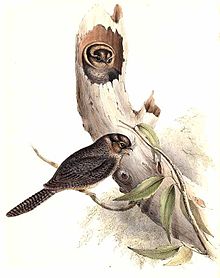Cave Dwarf
| Cave Dwarf | ||||||||
|---|---|---|---|---|---|---|---|---|

Bennett Schwalm ( Aegotheles bennettii ) |
||||||||
| Systematics | ||||||||
|
||||||||
| Scientific name of the family | ||||||||
| Aegothelidae | ||||||||
| Bonaparte , 1853 | ||||||||
| Scientific name of the genus | ||||||||
| Aegotheles | ||||||||
| Vigors & Horsfield , 1827 |
The cave dovids ( Aegotheles ) are a genus consisting of nine species in the family of the same name, the cave dewy (Aegothelidae) and belong to the order of the sailing birds (Apodiformes). Cave swallows are restricted to New Guinea , one species lives in Australia and Tasmania , another in the Moluccas and one in New Caledonia . They live in open and dense forests.
features
They resemble owls in their appearance, especially with their round head and sitting posture . However, they are smaller and reach lengths of 19 to 32 cm. Your eyes are sideways. The beak is small, hard and surrounded by long feathery bristles. Their legs are short and delicate in relation to their body. The short, broad beaks are surrounded by bristle-like feathers at the base of the beak. Their drawing consists of fine dark waves on a light base color or large white dots.
Way of life
The nocturnal and crepuscular birds rest during the day in tree hollows or on branches. You are loner. At night and at dusk, they look for insects , spiders and other invertebrates on the ground or they catch their prey in the air. Cave dwarves breed in tree hollows, sometimes also in caves on steep banks and spend the day there. They do not actually build a nest, but simply cover the ground with leaves. Your three to five eggs are white and speckled and have a silky sheen. The young birds are colored. Otherwise their reproductive behavior is unknown. Cave doves make cooing noises, low whistles, loud hisses and screeches.
Systematics
Cave swallows were until recently included in the order of the swallow-like (Caprimulgiformes), but are now included in the sailing birds (Apodiformes) because they are the sister group of the previous sailing birds and they make the swallow-like birds paraphyletic in relation to the sailing birds. The family relationships become clear in the following cladogram .
|
|
Swallow-like (Caprimulgiformes) |
|||||||||||||||||||||
|
|
||||||||||||||||||||||
| Sailing birds (new) |
|
|||||||||||||||||||||
|
|
species

- Archboldbergschwalm ( Aegotheles archboldi )
- Tree Swallow ( Aegotheles cristatus )
- Bennett Schwalm ( Aegotheles bennettii )
- Mountain Schwalm ( Aegotheles albertisi )
- Spotted Swallow ( Aegotheles wallacii )
- Owl swallow ( Aegotheles insignis )
- Moluccan Swallow ( Aegotheles crinifrons )
- Black- backed Swallow ( Aegotheles savesi )
- Lowland owl ( Aegotheles tatei )
swell
- Gottfried Mauersberger: Urania animal kingdom, birds. Urania-Verlag, 1991, ISBN 3-332-00491-3 .
- Frank Gill and Minturn Wright: BIRDS OF THE WORLD Recommended English Names. Princeton University Press, 2006, ISBN 0-7136-7904-2 .
- Species in the genus Aegotheles
Web links
Individual evidence
- ↑ Hackett et al .: A Phylogenomic Study of Birds Reveals Their Evolutionary History . Science 27 June 2008: Vol. 320. no. 5884, pp. 1763 - 1768 doi: 10.1126 / science.1157704
- ↑ Mayr, Gerald (2002): Osteological evidence for paraphyly of the avian or Caprimulgiformes (nightjars and allies). J. Ornithol. 143 (1): 82-97. doi: 10.1007 / BF02465461